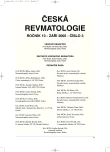Cryoglobulinemic vasculitis in a patient with chronic hepatitis C infection
Kryoglobulinemická vaskulitida u pacientky s chronickou infekcí virem hepatitidy C
V práci autoři upozorňují na možnost výskytu extrahepatálních manifestací chronické infekce virem hepatitidy C, z nichž mnohé se týkají pohybového aparátu a bývají někdy mylně považovány za zánětlivé revmatické onemocnění. Mezi ně patří i kryoglobulinemická vaskulitida. Poukazují na nutnost časné diagnostiky této infekce, neboť eradikace viru vede ve většině případů k úplnému vymizení extrahepatálních projevů. Problematika je dokumentována případem 43leté pacientky s dlouholetou anamnézou polyartralgií, artritid, myalgií, únavy a subfebrilií, Raynaudova fenoménu a kožních projevů na horních a dolních končetinách histologicky verifikovaných jako urtikariální vaskulitida. Imunosupresivní léčba neměla u nemocné odpovídající efekt. Po sérologickém potvrzení suspekce na infekci virem hepatitidy C s následným podrobným hepatologickým vyšetřením byla zahájena protivirová terapie, která vedla k vymizení subjektivních i objektivních příznaků choroby.
Klíčová slova:
virus hepatitidy C, extrahepatální manifestace, smíšená kryoglobulinemie, kryoglobulinemická vaskulitida
Authors:
R. Svobodová 1; L. Šedová 1; E. Ebenová 2; P. Urbánek 3
Authors‘ workplace:
Revmatologický ústav, Praha
1; NsP Karviná
2; IV. interní klinika VFN, Praha
3
Published in:
Čes. Revmatol., 13, 2005, No. 3, p. 110-115.
Category:
Case Report
Overview
The authors highlight the possible occurrence of extrahepatic manifestations of chronic infection of hepatitis C virus. Many of them are related to locomotive apparatus and sometimes misinterpreted as inflammatory rheumatic disease. One of them is represented by cryoglobulinemic vasculitis. The authors emphasize the necessity of early diagnosis of this infection because its eradication can lead to complete remission of the extrahepatic manifestations. The paper deals with the case report of 43-year-old patient with long history of polyarthralgias, arthritis, myalgias, fatigue and mild fever. She also suffered from Raynaud’s phenomenon and skin manifestations on both upper and lower extremities that were histologically verified as urticarial vasculitis. Immunosuppressive treatment had no appropriate effect. When suspicion for chronic infection of hepatitis C virus was confirmed, antivirus treatment led to a disappearance of subjective and objective manifestations of the disease.
Key words:
hepatitis C virus, extrahepatic manifestation, mixed cryoglobulinemia, cryoglobulinemic vasculitis
Labels
Dermatology & STDs Paediatric rheumatology RheumatologyArticle was published in
Czech Rheumatology

2005 Issue 3
Most read in this issue
- Antibodies against cyclic citrullinated peptide (anti-CCP) in serum and synovial fluid from patients with rheumatoid arthritis and osteoarthritis
- Cryoglobulinemic vasculitis in a patient with chronic hepatitis C infection
- Dysimmune myopathies (idiopathic inflammatory myopathies)
- Association of rheumatoid arthritis and Castleman’s disease
